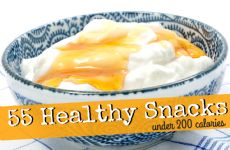|
There's a reason it's a prop in pretty much every breakup scene of every romantic movie: After all, it wouldn't be quite as comforting to curl up on the couch with a bowl of broccoli. But you don't have to be freshly single to appreciate the cold, creamy deliciousness of a pint of ice cream—it's also the treat of choice for celebrating birthdays, cooling off on summer afternoons or simply indulging a sweet tooth on a random Tuesday. However, unless you're super disciplined about portion sizes (rocky road and restraint don’t usually go hand-in-hand), screaming for ice-cream on the regular isn’t exactly conducive to a health and weight loss plan. But parting with it is such sweet sorrow…so what's a frozen treat fanatic to do? Enter alternative ice creams. In response to the large demand for the tastiness of ice cream without the extra calories or sugar, a slew of so-called "healthy" ice creams—some of the most popular include Halo Top, Arctic Zero, Wink and Thrive—are filling the frozen food aisles of most supermarkets. Their packaging promises the best of both worlds: the amazing taste of ice cream, with a sliver of the calories, fat and sugar of the real thing, sending well-intentioned dieters scurrying to satisfy their sweet cravings. Some even tout the added benefit of an extra protein boost. At first glance (and first taste), it might seem like you've hit the dessert lottery—but most registered dietitians and nutritionists warn that if something seems too good to be true, it usually is. How Are Healthy Ice Creams Made?SparkPeople's registered dietitian, Becky Hand, breaks down how these alternative ice creams are created:
Trading the Real Thing for the Fake ThingLiza Baker, health coach with Simply: Health Coaching, says today's "healthy" ice creams are a sign that we're still living in a fat-phobic era. "Starting in the 70s, we were taught that fat (especially saturated fat from animal products) is evil and should be avoided, but there is a lot of evidence now that our bodies do need moderate amounts of beneficial fat," she says. Unfortunately, fat is what adds flavor, so when you take out the fat, Baker warns that you wind up with a lot of synthetic flavors, artificial sweeteners and sugar alcohols to make the product palatable. In addition to affecting taste, removing fat also impacts what Baker calls the "mouthfeel" of a food—which means the manufacturer will then add gums and other fillers to their products in an attempt to replicate that delicious, creamy texture. Baker says it's better to enjoy "real" ice cream with the fewest number of whole ingredients as possible (think cream, milk, eggs, sugar, dark chocolate, fruit and other natural stuff), enjoyed in ½-cup servings. "It's a lot better to eat a small amount of healthy fat than a large amount of highly processed sugar," she says. "Enjoying an occasional treat is not unhealthy. What's unhealthy is our inability to resist huge portions on a regular basis, plus the use of highly processed ingredients." How 'Healthy' Ice Creams Affect Portion ControlRegistered dietitian Alissa Rumsey points out another potential problem with "healthier" ice creams: They lead to the idea that because they are supposedly better for you, you can eat as much as you want. "This type of thinking leads to overeating, because instead of responding to your body's feelings of fullness and satiety, it becomes 'I'm going to eat it all because I can,'" she says. The other issue is that these ice creams usually aren't as satisfying as the real thing. "If you're really craving ice cream and try to eat one of these instead, you aren't going to feel satisfied and will likely end up continuing to eat and graze on foods to try to find that feeling of satisfaction," Rumsey warns. "On the other hand, if you just have some real ice cream, you'll feel more satisfied and probably end up eating less." 10 Better Ice Cream AlternativesIf you're craving a cold treat but don't trust yourself to stick to the ½-cup portion size—and you want to avoid the artificial additives found in today's trendy "healthy" ice creams—try these lower-calorie, real-food alternatives that won't freeze your progress:
Have you tried "healthier" ice creams? What did you think? Join us each month as we sift through the so-called life hacks and miracle cures to get to the bottom of the latest buzzworthy trend. Get the facts and decide for yourself if you should Spark It or Scrap It. |
More From SparkPeople
|



.jpg)





.jpg)









